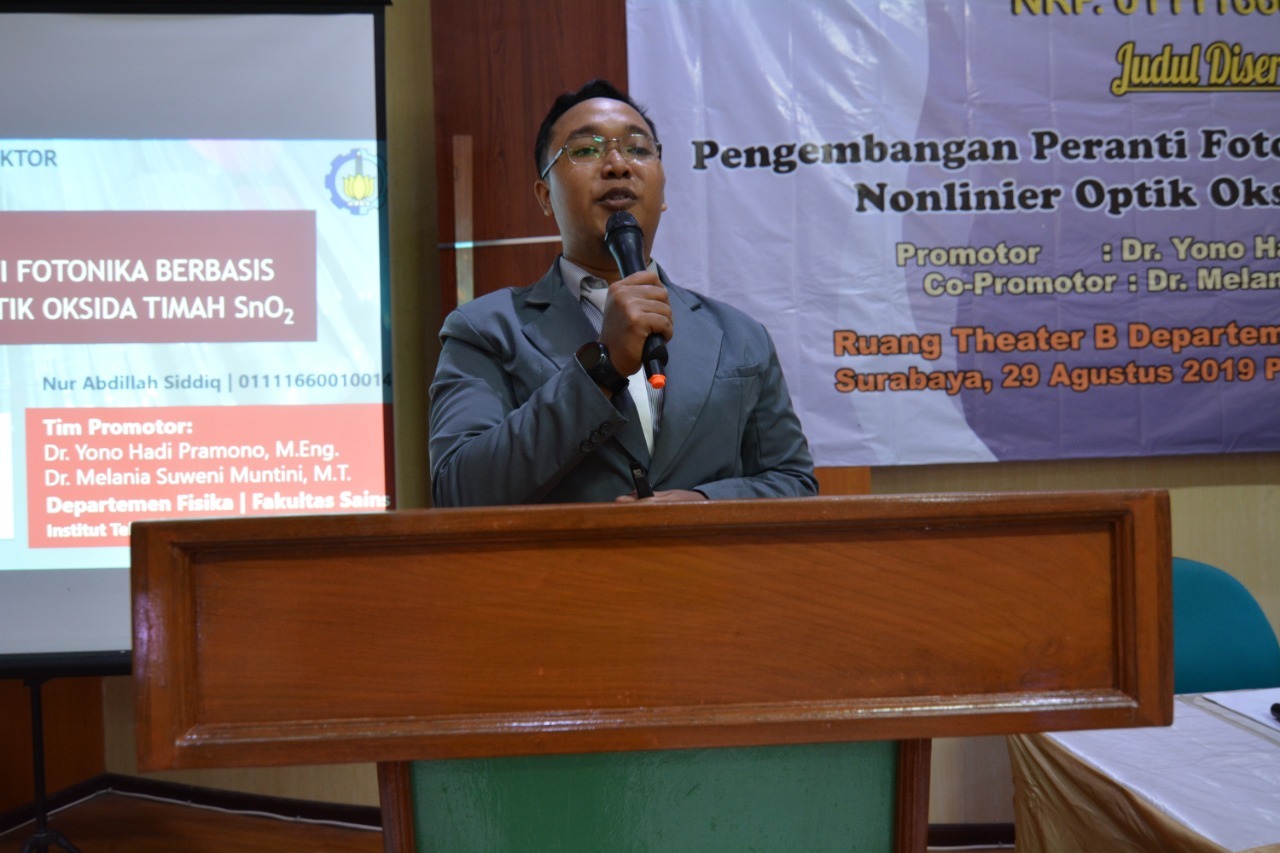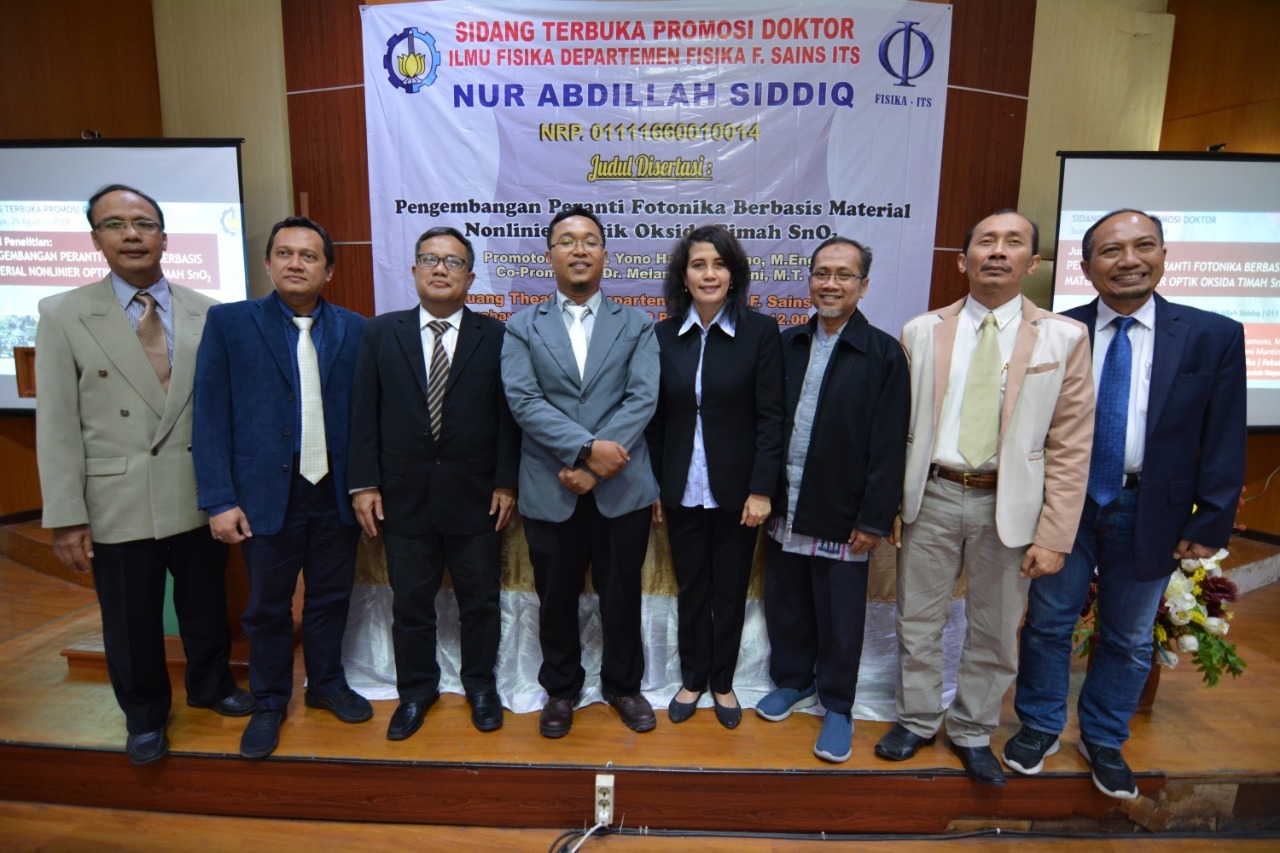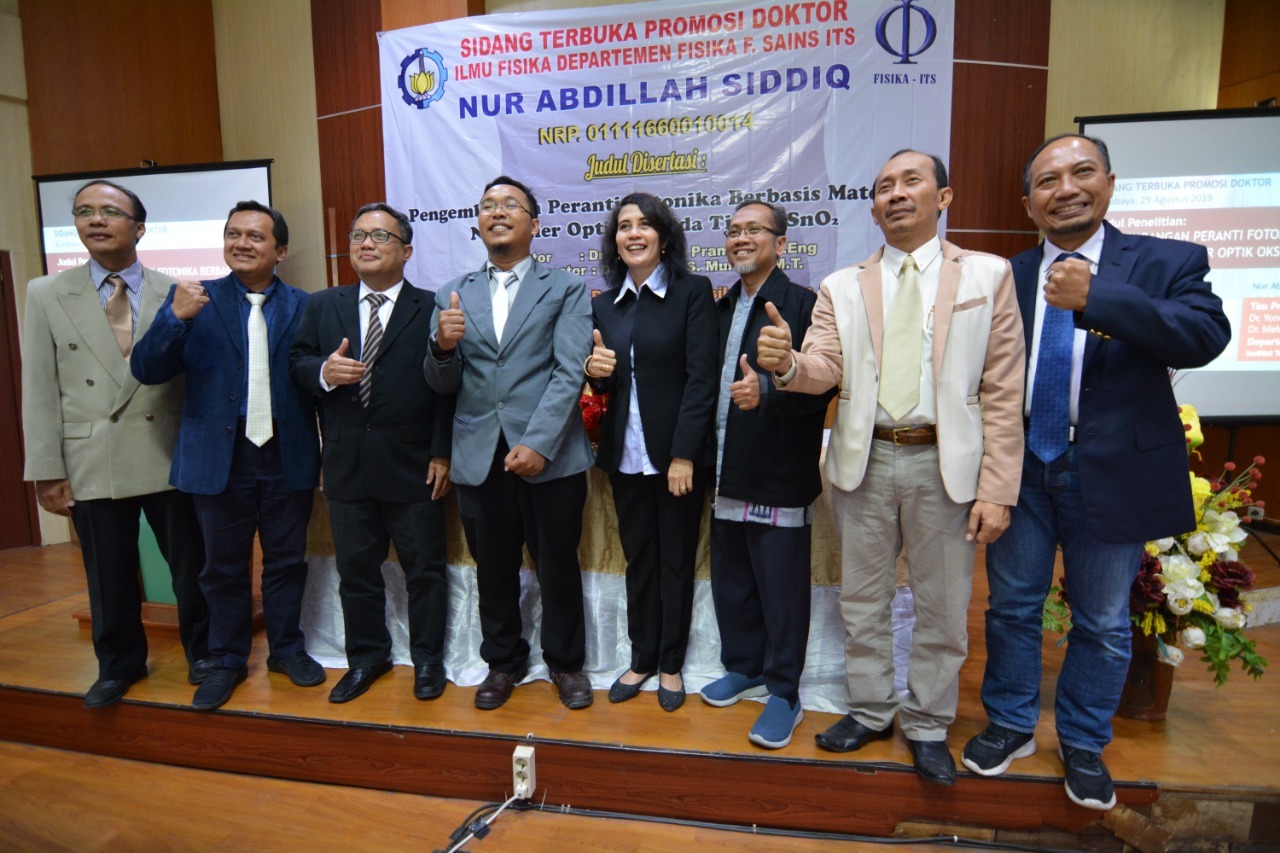ITS Doctorate Develops Tin Oxide for Laser and Sensor Materials

Nur Abdillah Siddiq presented his dissertation in the open session of doctoral promotion in ITS Physics
ITS Campus, ITS News – Referring to the current technological advancements, particularly in the field of photonics, Nur Abdillah Siddiq, Physics Doctorate of Masters to Doctoral Education Program for Superior Bachelor (PMDSU) Department of Physics Faculty of Science Institut Teknologi Sepuluh Nopember (ITS) examines the utilization of tin oxide as Saturable Absorber (SA) which is the most important component in the Q-Switched fiber laser. This research is presented in his dissertation presented at an open session of doctoral promotion, Thursday (29/8).
Siddiq, his nickname, revealed that he has been very interested in optics since studying undergraduate. That led him to research on optical fiber laser with nonlinear material which is tin oxide. “Besides, this research is relatively new and there has been no research on this matter before,” said Siddiq after the trial.
The session that promoted by Dr. Melania Suweni Muntini MT and Dr. Yono Hadi Pramono MEng explained about one of the main components of the Q-switched laser, namely the Saturable Absorber. An example of material made by the laser is Nd: YAG. Nd: YAG is a rare earth metal that is too expensive. “Therefore I made the material from tin oxide,” said Siddiq.
Siddiq explained, tin became the main ingredient because Indonesia is the second-largest tin producing country in the world. The number one largest tin-producing country is China. Besides that, Indonesia’s tin production is about 26.77 percent of the total world production. “I want to utilize tin produced by Indonesia so that it can be of economic value,” said the ITS Physics Engineering alumnus.

Nur Abdillah Siddiq (four from left) along with the promoters and examiners after the open session of doctoral promotion in ITS physics
Siddiq said, tin oxide has many advantages, namely ease in modifying its properties (doping, dimensions, synthesis parameters), its bandgap value that relatively large (3.6 eV), and included in the category of wide bandgap semiconductor. Its transparent nature is in the range of visible light (transmittance more than 97 percent at a thickness of 0.1 μm to 1 μm). “Also, tin oxide has high physics and chemical stability,” he explained.
According to Siddiq, tin oxide also has the advantages over other substances such as high electron mobility (250 cm2 V − 1 s − 1), relatively high optical nonlinearity (3.8 × 10-12 ESU), and easy preparation at relatively low temperatures (under 200 Celsius). “Surely the price of tin is relatively cheap,” said Siddiq.
The purpose of this research itself, continued Siddiq, was to find out the results of the Q-switched laser performance testing such as operating wavelengths, the effects of pumping laser power, stability, and obtaining the value of optical nonlinearity of SnO2 in terms of saturable absorption. “As well as knowing the right method in the SnO2 deposition process to actualize a passively Q-switched laser,” explained Siddiq further.
The results of this research have been published in the international journals that reputable and Scopus indexed such as Laser Physics and Optics Communication. Siddiq said this research has two benefits. The first benefit is that the laser with tin oxide can utilize the natural potential of Indonesia so that the tin can be managed into SnO2. The second benefit is getting an initial study of tin oxide in a Q-switched fiber laser. “More in-depth studies are needed to develop this laser into the commercial realm,” said Siddiq.

Nur Abdillah Siddiq (four from left) along with the promoters and examiners after the open session of doctoral promotion in ITS physics
Meanwhile, according to Melania, Siddiq’s research is research that has high scientific and commercial value. Especially because the SnO2 material exists in Indonesia. If it will be used as a research roadmap until the downstream and fabrication, then Indonesia will have a Photonic Integrated Circuit (PIC). The PIC can break the IC capability limit to become a PIC. “Indeed this is hard but not something impossible, hopefully, the government is also interested in developing high technology in Indonesia,” Ujar Melania.
The hope is that with this research, the Q-switched fiber laser that has been researched can be developed continuously. “The Q-Switchedit fiber Laser can also be developed so that it can be used to fight tumors inside the human body,” he concluded. (qin/gayatri/ITS Public Relation)
Related News
-
ITS Students Win Short Video Competition in Russia
ITS Campus, ITS News — The achievements of civitas academica of Institut Teknologi Sepuluh Nopember (ITS) continue to shine
September 09, 2019 08:09 -
ITS Academics Voice Concerns on the Difficulty of Achieving Professor Title in Design to the Minister of PAN-RB
ITS Campus, ITS News – In line with its commitment to improving human resources, the Minister for Administrative and
September 09, 2019 08:09 -
Gerigi ITS 2024, a Spark of Enthusiasm for Freshmen Contributions
ITS Campus, ITS News — Institut Teknologi Sepuluh Nopember (ITS) again held Generasi Integralistik (Gerigi) as a place to
September 09, 2019 08:09 -
ITS Team Wins the Sustainable Bridge Competition 2024
ITS Campus, ITS News — Students of Institut Teknologi Sepuluh Nopember (ITS) made more brilliant achievements in the construction field.
September 09, 2019 08:09
